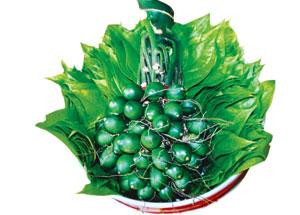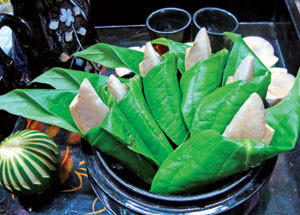Betel and areca nut love
A large, well-prepared wedding will have a full offering of a bunch of areca nuts and a hundred betel leaves; a small, simply prepared wedding will also have a bunch of areca nuts and a bunch of betel leaves on a plate.
From ancient times until now, whether the wedding follows the customs of the North - Central - South or even the West, Vietnamese weddings cannot lack the betel and areca tray.
 |
The ancients believed that the areca tree with its round, sturdy, upright trunk was a symbol of a man, while the betel leaves, with their plump triangular shape spreading horizontally on the ground, were a symbol of a woman. The betel vine that wraps around the areca tree is also a symbol of lasting love. Betel and areca nut eaten with a little lime creates a reddish-pink color like the color of blood, or vermilion – red symbolizing loyalty.
In folklore, it is still passed down by word of mouth: “A piece of betel is eaten as a pair/The betel leaf is the wife, the fresh areca nut is the husband/Green betel, white areca nut, pink areca nut/Lime mixed with meaning, strong tobacco with fate…”. For girls, betel and areca nut are also considered a symbol of honorable reception so that they can be proud for life, so that they can be legitimate and teach their children, grandchildren, subordinates and even the “future concubines”. Girls who are asked to marry with “betel in hand, ceremony on head” have the right and responsibility to fulfill the duties of a good wife and a good daughter-in-law.
In the old villages, after the engagement ceremony, the bride's family often used the betel nuts, tea and cakes that the groom's family brought over, divided into small packages to give as gifts to relatives, friends, neighbors... as an announcement: the daughter in the family has a place.
 |
Betel nuts are more or less influenced by the lifestyle, thinking and style of modern people. When preparing for a wedding, the worry is almost only for the “material” part such as booking a restaurant, taking photos, renting dresses, renting cars, printing invitations…
Ms. Bich Ngoc, owner of stall 1113 specializing in selling Ba Diem betel and areca nuts at Ben Thanh market, whose family has been in the business of making betel leaves and areca bunches for engagement and wedding ceremonies for three generations since the 1940s, said: "Nowadays, people mainly do betel and areca nut ceremonies in a conventional way, because few people eat them, so almost all the trays of gifts for the ceremonies are outsourced to services."
So what is a modern betel nut gift that is still in accordance with the ceremony? Ms. Bich Ngoc, based on the experience of customers and the family's sales tradition, instructed: because people in Saigon today no longer have the custom of sharing gifts from the groom's family to relatives and neighbors, the betel nut tray only needs 6 pieces of betel leaves and areca nuts split into 6. Notably, according to the Northern custom, the betel must be folded like phoenix wings, the betel leaves must be the spicy, thick-leafed green type, the lime used is the white Northern lime and the commonly used tobacco is tobacco, and the red peel. According to the Southern custom, the betel is folded like a banh ú cake, the betel leaves are the sweet type (usually Ba Diem betel) with red lime, tobacco and paper peel.
If the engagement ceremony is held with many attendees, and to make the filming and photography beautiful, the tray of betel leaves will also be accompanied by a gift consisting of a full bunch of areca nuts and betel leaves, which can range from a few dozen to a few hundred nuts - but must be an even number - in pairs. How to calculate the number of areca nuts and betel leaves: 1 areca nut = 2 betel leaves. In addition, modern Northerners prefer a bunch of 105 areca nuts according to the saying "a hundred years of happiness". Southerners choose a bunch of 60 areca nuts according to the metaphor "60 years of life".
| According to Vietnamese custom, to complete a wedding, there must be 6 ceremonies, called Luc Le: 1. Nap thai: the groom's family sends someone to the bride's family to suggest that they want to choose a daughter from that family to be their daughter-in-law. 2. Asking for the girl's name: the groom's family asks a matchmaker to ask for the girl's name and date of birth (to see if she is compatible or not). 3. Dowry: the groom's family informs the bride's family that they have checked the couple's age and fortune, everything is good and they want to proceed with the wedding. 4. Nap Te (nap Trung): the groom's family brings the dowry to the bride's family to hold the ancestral ceremony and introduce themselves. This ceremony is usually called the engagement ceremony. 5. Request: the groom's family asks the bride's family to set a date to pick up the bride. 6. Than nghinh: the ceremony of bringing the bride to the groom's house, that is, the wedding ceremony. Many people believe that choosing a bunch of 60 areca nuts also symbolizes the calculation of "birth - aging - sickness - death - birth - aging", which will help couples live together until they are old and toothless, overcoming all the difficulties and hardships of life. |
According to Economics and Urban






